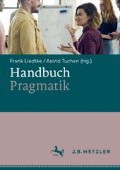Zusammenfassung
Der Begriff ›Ellipse‹ wird in der Literatur nicht einheitlich verwendet und ist aufgrund der Heterogenität des Phänomenbereichs auch nicht ganz einfach zu definieren. In erster Annäherung kann man unter Ellipsen sprachliche Äußerungen verstehen, die in einem zu präzisierenden Sinne unvollständig sind oder von kompetenten Sprecher/innen (des Deutschen) als unvollständig aufgefasst werden.
Access this chapter
Tax calculation will be finalised at checkout
Purchases are for personal use only
Preview
Unable to display preview. Download preview PDF.
Literatur
Asher, Nicholas/Lascarides, Alex (2003): Logics of Conversation. Cambridge.
Auer, Peter (1993): Zur Verbspitzenstellung im gesprochenen Deutsch. In: Deutsche Sprache 23, 193–222.
Barton, Ellen (1990): Nonsentential Constituents. Amsterdam.
Büring, Daniel/Hartmann, Katharina (1998): Asymmetrische Koordination. In: Linguistische Berichte 174, 172–201.
Carston, Robyn (2002): Thoughts and Utterances: The Pragmatics of Explicit Communication. Malden.
Chomsky, Noam (1957): Syntactic Structures. Cambridge, Mass.
Christ, Rüdiger (2011): Linkstilgung und Phonologische ›Quasi‹-Identität. In: Linguistische Berichte 228, 371–411.
Culicover, Peter/Jackendoff, Ray: (2005): Simpler Syntax. Oxford.
Frey, Werner (2000): Über die syntaktische Position der Satztopiks im Deutschen. In: ZAS Papers in Linguistics 20, 137–172.
Frick, Katharina (2017): Elliptische Strukturen in SMS. Eine korpusbasierte Untersuchung des Schweizerdeutschen. Berlin/Boston.
Fries, Norbert (1988): Über das Nulltopik im Deutschen. In: Sprache und Pragmatik 3, 19–49.
Ginzburg, Jonathan/Sag, Ivan (2000): Interrogative Investigations: The Form, Meaning, and Use of English Interrogatives. Stanford.
Haegeman, Liliane (2013): The syntax of registers: Diary subject omission and the privilege of the root. In: Lingua 130, 88–110.
Hankamer, Jorge (1979): Deletion in Coordinate Structures. New York.
Hankamer, Jorge/Sag, Ivan (1976): Deep and surface anaphora. In: Linguistic Inquiry 7, 391–426.
Hartmann, Katharina (2000): Right Node Raising and Gapping. Interface Conditions on Prosodic Deletion. Philadelphia/Amsterdam.
Höhle, Tilman N. (1990): Assumptions about asymmetric coordination in German. In: Joan Mascaró/Marina Nespor (Hg.): Grammar in Progress. Glow Essays for Henk van Riemsdijk. Dordrecht, 221–235.
Horch, Eva/Reich, Ingo (2017): The Fragment Corpus (FraC). In: Proceedings of the 9th International Corpus Linguistics Conference, Birmingham (UK), https://www.birmingham.ac.uk/Documents/college-artslaw/corpus/conference-archives/2017/general/paper194.pdf.
Jacobs, Joachim (2008): Wozu Konstruktionen? In: Linguistische Berichte 213, 3–44.
Johnson, Kyle (im Druck): Gapping and stripping. In: Jeroen van Craenenbroeck/Tanja Temmermann (Hg.): The Oxford Handbook of Ellipsis. Oxford.
Klein, Wolfgang (1993): Ellipse. In: Joachim Jacobs/Arnim von Stechow/Wolfgang Sternefeld et al. (Hg.): Syntax. Ein internationales Handbuch zeitgenössischer Forschung. 1. Halbband. Berlin/New York, 763–799.
Klein, Wolfgang/Stutterheim, Christiane von (1987): Quaestio und referentielle Bewegung in Erzählungen. In: Linguistische Berichte 109, 163–183.
Konietzko, Andreas (2016): Bare Argument Ellipsis and Focus. Amsterdam/Philadelphia.
Lechner, Winfried (2004): Ellipsis in Comparatives. Berlin/New York.
Lemke, Robin (2017): Sentential or not? – An experimental study on the syntax of fragments. In: Sam Featherston/Robin Hörnig/Reinhild Steinberg et al. (Hg.): Proceedings of Linguistic Evidence 2016, University of Tübingen, online publication system, https://publikationen.unituebingen.de/xmlui/handle/10900/77066.
Lemke, Robin/Schäfer, Lisa/Reich, Ingo (2018): Don’t be uninformative! – Experimental Studies on Information Theory and Fragment Usage. Poster at Cuny 2018, Davis, CA. In: https://osf.io/583qd/.
Lobeck, Anne (1995): Ellipsis. Functional Heads: Licensing, and Identification. New York/Oxford.
Merchant, Jason (2001): The Syntax of Silence – Sluicing, Islands, and the Theory of Ellipsis. Oxford.
Merchant, Jason (2004): Fragments and ellipsis. In: Linguistics and Philosophy 27, 661–738.
Merchant, Jason (2006): Sluicing. In: Martin Everaert/Henk van Riemsdijk (Hg.): The Syntax Companion. London, 271–290.
Merchant, Jason (im Druck): Ellipsis: A survey of analytical approaches. In: Jeroen van Craenenbroeck/Tanja Temmermann (Hg.): The Oxford Handbook of Ellipsis. Oxford.
Napoli, Donna Jo (1985): Verb phrase deletion in English: A base-generated analysis. In: Journal of Linguistics 21, 281–319.
Ott, Dennis/Struckmeier, Volker (2018): Particles and deletion. In: Linguistic Inquiry 49(2), 393–470.
Recanati, François (2010): Truth-Conditional Pragmatics. Oxford.
Reich, Ingo (2002): Question/Answer-Congruence and the semantics of wh-phrases. In: Theoretical Linguistics 28, 73–94.
Reich, Ingo (2003): Frage, Antwort und Fokus. Berlin.
Reich, Ingo (2007): Toward a uniform analysis of short answers and gapping. In: Kerstin Schwabe/Susanne Winkler (Hg.): On Information Structure, Meaning and Form. Amsterdam/Philadelphia, 467–484.
Reich, Ingo (2009): »Asymmetrische Koordination« im Deutschen. Tübingen.
Reich, Ingo (2011): Ellipsis. In: Klaus von Heusinger/Claudia Maienborn/Paul Portner (Hg.): Semantics: An International Handbook of Natural Language Meaning. Bd. 2. Berlin/New York, 1849–1874.
Reich, Ingo (2017): On the omission of articles and copulae in German newspaper headlines. In: Linguistic Variation 17(2), 186–204.
Roberts, Craige (1996): Information structure: Towards an integrated formal theory of pragmatics. In: Jae-Hak Yoon/Andreas Kathol (Hg.): Ohio State University Working Papers in Linguistics, Bd. 49, Ohio State University. 91–136
Rooth, Mats (1992): Ellipsis redundancy and reduction redundancy. In: Steve Berman/Arild Hestvik (Hg.): Proceedings of the Stuttgarter Ellipsis Workshop. Number 29 in Arbeitspapiere des Sonderforschungsbereichs 340, 1–26.
Ross, John R. (1967): Constraints on Variables in Syntax. Ph.D. thesis, MIT. Cambridge, Mass.
Sag, Ivan A. (1976): Deletion and Logical Form. Ph.D. thesis, MIT. Cambridge, Mass.
Sandig, Barbara (1971): Syntaktische Typologie der Schlagzeile. Ismaning.
Schwarzschild, Roger (1999): Givenness, AvoidF and other constraints on the placement of accent. In: Natural Language Semantics 7, 141–177.
Sperber, Dan/Wilson, Deirdre (1987): Précis of relevance: Communication and cognition. In: Behavioral and Brain Science 10, 697–754.
Stainton, Robert J. (2006): Words and Thoughts: Subsentences, Ellipsis, and the Philosophy of Language. Oxford.
Stanley, Jason (2000): Context and logical form. In: Linguistics and Philosophy 23, 391–434.
Stowell, Tim (1991): Empty heads in abbreviated English. GLOW abstract. Leiden.
van Craenenbroeck, Jeroen/Temmermann, Tanja (Hg.) (2018): The Oxford Handbook of Ellipsis. Oxford.
Williams, Edwin (1977): Discourse and logical form. In: Linguistic Inquiry 8, 101–139.
Williams, Edwin (1995): Ellipsis. Ms., Princeton University.
Author information
Authors and Affiliations
Editor information
Editors and Affiliations
Rights and permissions
Copyright information
© 2018 Springer-Verlag GmbH Deutschland, ein Teil von Springer Nature
About this chapter
Cite this chapter
Reich, I. (2018). Ellipsen. In: Liedtke, F., Tuchen, A. (eds) Handbuch Pragmatik. J.B. Metzler, Stuttgart. https://doi.org/10.1007/978-3-476-04624-6_24
Download citation
DOI: https://doi.org/10.1007/978-3-476-04624-6_24
Publisher Name: J.B. Metzler, Stuttgart
Print ISBN: 978-3-476-04623-9
Online ISBN: 978-3-476-04624-6
eBook Packages: J.B. Metzler Humanities (German Language)

